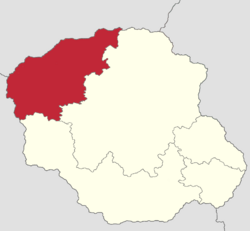Holsaten Community
Holsaten Community
| |
|---|---|
|
Coat of arms of Holsaten Community Coat of arms | |
 The Holsaten Community within Alsland | |
| Country | |
| Provinces | Der Lemer Wahnerschloss |
| Established | 2009 |
| Capital | Werdau |
| Government | |
| • Executive | Holsaten Government |
| • Governing coalition | HSAI, PA, HSU, GAK |
| • Minister-President | Ann-Katrin Steinbauer |
| • Legislature | Holsaten Parliament |
| • Provincial Minister-Presidents | X |
| Population | |
| • Total | 2,251,853 |
The Holsaten Community (Holsaten: Holsaten-Gemeinschaft, Dellish: Holsatener Mienskip) also known as Holsteen, is a Polity in Alsland and one of 4 Communities of Alsland. It has a population of 2,251,853 or 19.8% of the country's total population. The community is divided into two Provinces: Der Lemer and Wahnerschloss. Der Lemer is the only officially bilingual Province of Alsland and has a special status within the Holsaten community owing to it's sizeable Dellish population. The Community is also officially bilingual as both Dellish and the Holsaten language share equal status in regional law.
Holsteen was historically divided between the Province of Aarden and the Principality of Zittau alongside the Duchy of Delland, all 3 of which were members of the Rudolphine Confederation. In 1702 Garz and Zittau merged to form the Grand Duchy of Holsteen. Holsteen was absorbed by Kirenia after the Ten Years' War and later into the Weranian Republic in 1797. Pan-Weranicism was popular in Holsteen until the end of the War of the Triple Alliance when the region wasn't annexed into Werania. Holsateners were angered by this decision and Holsaten independence instead became popularised by Luis Pilz and Patrik Knauer. A Holsaten led revolution in 1861 popularised the idea of Alslandic nationalism across West Swerdia and Delland. Holsteen alongside Delland experienced major economic and industrial growth as a result of the Industrial revolution in Kirenia and quickly became the most economically prosperous regions in eastern Kirenia. During the 1919 Dellish revolution, Holsteen broke off from Delland and Kirenia to establish the short-lived Republic of Holsteen. The Levandi-Hartmann agreement ceded Holsteen and West Swerdia to Delland effectively abolishing the Republic of Holsteen. The Holsaten region's economy lagged behind the Dellish economy but experienced major economic growth in the late 70s and early 80s. Since the mid-2000s Holsaten separatism from Delland gained popularity with the rise of the FBB in Garz and resulted in the establishment of the Holsaten Community in 2009.
The Holsaten Community borders Werania to the north, Estmere in the north-east, the Swathish Community in the south-east, the Dellish Community to the south and Kirenia to the west.
History
Early History
Middle Ages
Early modern era
Modern era
Government and politics
Current Structure of the Holsaten Parliament | |
|---|---|
| Structure | |
| Seats | 190 |
 | |
Political groups | Government (96)
Opposition (94) |

The Holsaten Community is an autonomous Community of Alsland and has power over education, linguistic, cultural and local infrastructure policies like all other Communities of Alsland, the Community also has jurisdiction over the court system in it's territory. Holsteen has it's own Parliament which is elected every 4 years and has 190 members. At the last election in 2019, a coalition of the Holsaten Section of the Workers' International, Progressive Alliance, Humanist Sotirian Union and Green - Alternative Choice was formed and is led by Ann-Katrin Steinbauer of the Holsaten Section of the Workers' International.
The head of the Holsaten Community is the Minister-President of Holsteen which has been Ann-Katrin Steinbauer since 2015. Similar to the other Communities, the Minister-President of Holsteen is elected through a direct popular vote which uses the ranked-choice voting system to elect the position. If a Minister-President resigns or the office becomes vacant an election must be held within 60 days to fill the vacancy, whilst in other Communities a vacancy is usually filled by the regional legislative body until the original term expires.
Politics
Similarly to federal politics, the provinces which make up Holsteen were dominated for much of the second half of the 20th century by the National Bloc which was in power in Der Lemer and Wahnerschloss from the 1940s until the 1980s with only a brief exception in 1961. The National Bloc lost power in both provinces in 1987 to a Humanist Sotirian Union and Holsaten Section of the Workers' International in a grand coalition which implemented electoral reforms in the provinces to as well as laying the groundwork for future autonomy in the region. In 1991 the anti-taxation, regionalist right-wing Free Citizens Movement (FBB) won power in Der Lemer. Their election coincided with a growth in support for the Holsaten independence movement which the party is supportive of, however the party was divided on whether unification with Werania or community status inside Alsland was preferable. In 2006 both Provinces voted to have community status in Alsland which was granted in 2009. In 2011, Matz Heine and Liveable Alsland won and formed coalitions with the Free Citizens Movement. The coalition broke apart ahead of the 2015 election and Ann-Katrin Steinbauer won leading a broadly left-wing coalition. Recently the FBB have adopted policies associated with the far-right. Other parties in Holsteen are the Progressive Alliance, Green - Alternative Choice and Orange Party.
Provinces
Geography
Economy
Infrastructure
Transport
Demographics
Language
Dellish minority
Religion
Education
Healthcare
Culture
Literature
Media
Music

